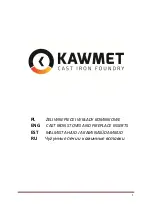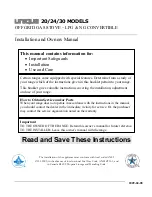
Burning for Higher Heat Output
These instructions are intended as a guide to operating your wood stove. Your timing and final damper settings will
vary depending on chimney draft, type of wood, moisture content of the wood and size of the splits. The Ideal Steel
Hybrid is simply designed and intended to be user friendly, but it will take some practice to understand how the stove
works best for you.
1.
Before you open the loading door, you must fully open the catalytic bypass and the air damper. Wait a minute or so
to establish a strong draft. This will help to keep smoke from spilling into the room.
2.
Open the load door and tip the andirons forward (see image on pg 15)
.
Stir up the coals and remove excess ash as
needed.
3.
Place several small splits on top of the hot coals and allow them to ignite.
4.
Load the firebox to capacity, leaving about a 2”space for secondary combustion at the top, with a mix of larger and
smaller splits. Tip the andirons to the upright position. Close the loading door.
5.
Allow the fresh wood to become involved in the fire. With dry wood this may take 5-15 minutes, or until the exterior
of single wall pipe reaches 250°. Slide the air damper lever to the left and close approximately half way.
6.
Close the catalytic bypass by lowering the lever until it stops.
7.
You should see the flames from secondary combustion at the top of the firebox becoming more active. Adjust the
air damper to approximately 1/3 open.
Ash Removal
NEVER BURN THE STOVE WITH THE ASH DOOR OPEN
!
Without an ash pan:
If your Ideal Steel Hybrid does not have an ash pan you will have to remove ash through the front loading door,
approximately every 5-7 days if the stove is in continuous operation. You do not have to
let the fire die out completely to remove the ashes, but the fire must be reduced to hot
coals. First make sure that both the catalytic bypass damper and the air control damper
are open. This will increase the draft and prevent smoke from entering the room.
Open the front door and tip the andirons forward. Move the hot coals to one side or the
back of the firebox. Scoop out the ashes that were underneath the coals, and then reverse
the procedure. Leave some ash and hot coals in the bottom of the stove to help rekindle
a fire.
With an ash pan:
If your Ideal Steel is in continuous operation, you will probably need to empty the
ash pan every 7-10 days. You do not have to let the fire die out completely, but make
sure that it is reduced to hot coals. Open the catalytic bypass damper, and open the air
control damper. Remember to wear stove gloves - the ash pan will be hot! Open the ash
pan door located at the front of the stove, below the loading door. Carefully slide the lid
into place on the top of the ash pan and remove the ash pan from the base of the stove.
The lid slides over the long top edges of the ash pan. Close the ash pan door before
emptying the ashes into an appropriate container.
Do not open the ash removal door while the stove is in the middle of a long burn,
because the additional draft created under the fire could cause the stove to burn
excessively hot and the ash pan itself will be very hot, and full of live coals. If you are
burning your stove 24 hours/day, it is often easiest to empty the ashes first thing in the
morning, after an overnight burn.
Ashes should be emptied into a metal container with a tight fitting lid. The closed container of ashes should be
placed on a noncombustible floor or on the ground, well away from all combustible materials, pending final disposal. If
the ashes are disposed of by burial in soil or otherwise locally dispersed, they should be retained in the closed container
until all cinders have thoroughly cooled. Live cinders can take 36 hours or longer to cool.
Never shovel ashes into a combustible container like a cardboard box or a plastic bucket. Do not use a vacuum
cleaner to remove ashes unless it is specifically designed for woodstove ash removal. NEVER leave a container of
hot ashes on a wood floor, porch, or any combustible surface.
16
The ash Pan door is located at the
front of the stove, below the ash lip.
The ash pan door drops down and the
ash pan slides out from under the
stove for easy ash removal.
















































